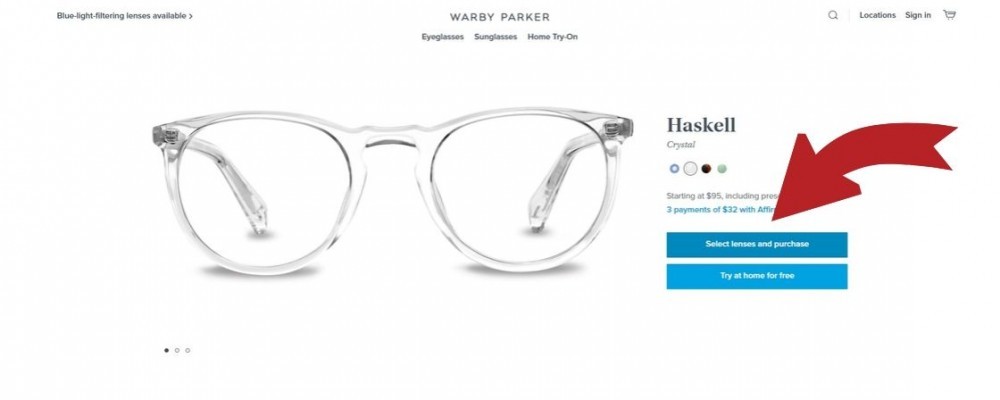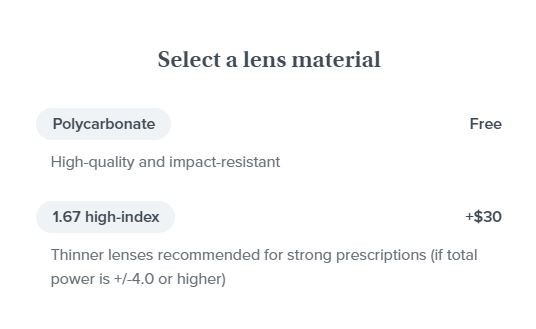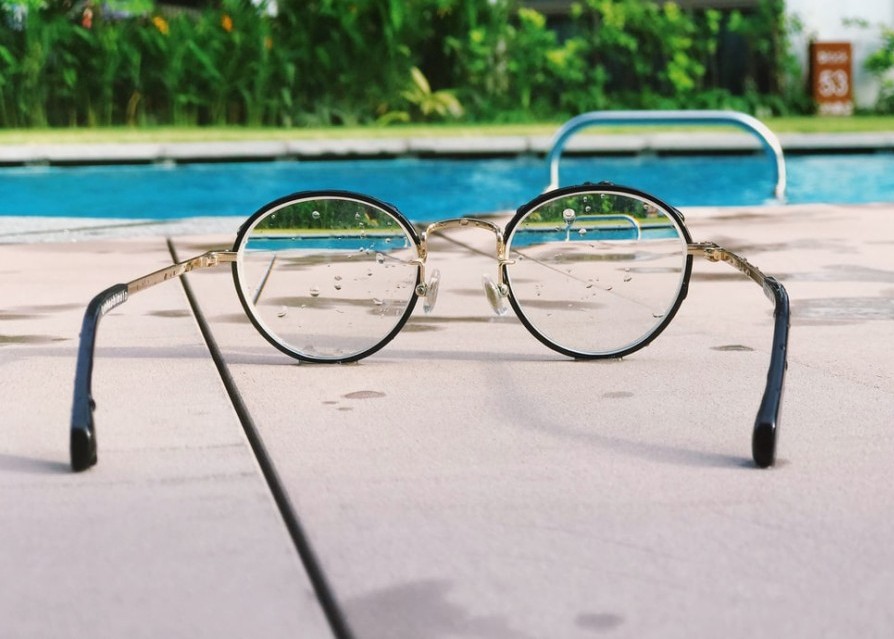Bear in mind that some of the links on this website are affiliate links. If you go through them to make a purchase we will earn a commission at no extra cost to you but helps support our website. Keep in mind that we link these companies and their products because of their quality and not because of the commission we receive from your purchases.
If you are a fan of popular eyewear brand Warby Parker but have a prescription that is on the stronger side you may be wondering what options you have when it comes to high-index lenses.
High-Index lenses will provide you with the lightest, thinnest, and most cosmetically appealing lens. This helps by keeping the overall weight of your eyeglasses down and provides a thin and slick looking pair of glasses. Of course, depending on what type of frame you go with, you can use the frame to help hide the thickness better. For example, if you were to pick an acetate (plastic) frame the lenses would be much more hidden due to the thicker frame design compared to if you were to pick a metal frame which would stick out much more due to the frame being much thinner.
Regardless of what type of frame you pick if you have a strong prescription, Warby Parker has two high-index options, a 1.67 high-index lens, as well as a 1.74 ultra high-index lens but which one should you go with? I’ll explain more below.
Table of Contents
Warby Parker High-Index Lenses
Whenever we have a refractive error our eyes are having trouble focusing light onto your retina and prescription glasses help us see better by bending that unfocused light. The stronger your prescription, the more lens material is needed in order to bend that light so you can see.
High-index lenses are lighter and thinner due to the lens material being more efficient at bending light. The measurement that is used to show how efficient a lens material could bend light is known as the index of refraction, or also known as the refractive index. The higher the refractive index the more efficient that material is at bending light, and due to it being more efficient at bending light, less lens material is needed. The result is a lighter, thinner and more cosmetically appealing lens.
As I mentioned before, Warby Parker offers two types of high index lenses, but how do you know if you need high-index lenses? All Warby Parker glasses come standard with a polycarbonate lens which is a 1.59 Index lens, durable, and impact-resistant. Generally, if your prescription is mild with a total power of fewer than +2.00/-4.00 diopters you will be just fine with polycarbonate lenses. So when should you think about upgrading? Take a look below.
- 1.67 High-Index (+$30) – These lenses can be about 50-55% thinner than standard plastic lenses and about 15-20% thinner than standard polycarbonate lenses. It is definitely a lens that you should start thinking about getting if your prescription is stronger than +2.00/-4.00, but is definitely recommended if your prescription is +3.00/-6.00 diopters or higher. You should definitely take into consideration the type of frame that you are getting as well. As I mentioned before acetate or plastic frames will hide the thickness more, while metal frames will show the thickness more.
- 1.74 Ultra High-Index (+$130) – This lens is generally only recommended whenever your prescription starts getting close to or goes beyond +6.00/-8.00 diopters. This would give you the thinnest and lightest option that is currently available. When you are on Warby Parker’s website, the ultra high-index lens is not available for you to select, but Warby Parker’s customer service team will reach out to you with the option if your prescription is in the range that would warrant a ultra high-index lens.
How frame choice affects your prescription lenses
If you are someone that has a mile prescription, you can pick from pretty much all of the endless frame shapes and sizes configurations that are in existence. Of course there are certain limitations and there will be some frames that are either too big or too small for you, but for the most part, you can pick whatever you want. Those of us that have stronger prescriptions aren’t so lucky. Take a look below for some tips when picking out frames if you have stronger prescriptions.
Strong Nearsightedness (High minus power)
Most people are nearsighted and have a hard time focusing on things that are far away. When you are nearsighted the light rays that enter your eyes are not focusing directly on your retina but are incorrectly focusing in front of the retina. In order to correct this a lens that is thinner in the middle and thicker on the edges is needed to diverge light rays to reduce the eye’s focusing power. In turn, this moves the focus point from in front of the retina back onto the retina.
With this type of prescription due to the lenses being thicker on the edges, smaller, narrower frames with rounded edges would give you lenses that are thinner, lighter and much more cosmetically appealing. If you go with a large oversized frame you will risk your lenses creating the “coke bottle” look and have lenses that are thicker, heavier and stick out the sides of the glasses. Other frame types that could cause thickness include Rimless or semi-rimless frames which makes the thickness of the lenses more noticeable if you have a stronger prescription If your prescription is too strong, rimless frames might not work at all due to how the frames are designed which gives it limitations.
Strong Farsightedness (High positive power)
For people that have a strong farsighted prescription, instead of having trouble seeing things far away things that are nearby are blurry and out of focus. People that are farsighted do not have enough focusing power and therefore light rays that are entering do not focus at any point all the way up to the retina. Glasses help converge the light rays which help bring up the focusing power of your eye. When that happens this moves the eye’s focus point forward and onto the retina.
With this type of prescription, the lenses are thin around the edges but is thicker at the center of the lens. In order to keep the thickness down, you would need to find frames that are smaller and narrower. Oversized frames with big lenses will magnify your eyes making them very big and create a bug-eyed look.
How to order high-index lenses at Warby Parker
Choosing high-index lenses for your order with Warby Parker is quite simple and straight forward, but the first thing you will have to do is decide which frames you are going to go with. The wonderful thing about Warby Parker is that they offer you multiple options to help you decide on your frames.
The one that Warby is known for and something they have done since the beginning is the home try-on program. Warby Parker’s home try-on program allows you to select 5 frames from their website that you would like to physically try on. They will then mail you those 5 frames, and you have 5 days from the day that you receive the glasses to try them out. During that time you can try them all on, take photos, and get other people’s opinions. After that you simply would put all the frames back in the box they came in and stick on the prepaid shipping label provided for you in the box and give it to your mailman or take it to the local post office. The best thing about it is that you don’t even have to wait until the frames get back, if you know which frame you want, you can simply log back into the website and place your order.
Placing your order is simple, I’ll use the popular frame Haskell as an example:
 Once you find your frames press the “Select lenses and purchase” button which will take you to a page where you will be selecting the frame width (If your frame doesn’t come in any other sizes there will only be one option here), prescription type, lens type, and lens material.
Once you find your frames press the “Select lenses and purchase” button which will take you to a page where you will be selecting the frame width (If your frame doesn’t come in any other sizes there will only be one option here), prescription type, lens type, and lens material.
Prescription Type

At Warby Parker, for prescription lenses, you have one of two options single-vision or progressive lenses. Which one you go with will depend on your prescription and of course your personal preference. Here are your options.
- Single Vision (Included) – This type of lens has one prescription throughout the entire lens and could be made to correct near, intermediate or distance prescriptions. The majority of individuals only need single vision lenses, but if you do need glasses to correct distance as well as reading, it doesn’t mean that you can’t get single vision lenses. Some people opt for single vision over bifocals or progressive lenses and just have separate glasses for distance and reading for various reasons.
- Progressive (+$200) – Progressive lenses have three fields of vision that starts with your distance on the top portion of the lens and gradually goes from that to your reading prescription near the bottom. Progressive lenses give you one pair of glasses with multiple ranges so you don’t need to switch between glasses when looking at things in different ranges. There is no visible line with progressive lenses as your three prescriptions are blended together and gives the appearance of a single vision lens when someone is looking at you.
Keep in mind that if you are purchasing non-prescription readers or non-prescription lenses you will not be able to get high-index lenses. After you have selected which prescription type you wanted to go to with between single vision and progressive you will move onto selecting a lens type.
Lens Type

On this page, the various different lens types are completely optional but could be beneficial to you depending on your lifestyle and/or occupation. Let’s take a look at your options:
- Classic (Included) – The classic lenses come included with all your standard coatings including anti-reflective coating, scratch-resistance, and UV. This is the lens you could go with if you did not want any additional lens modifications and want glasses that are just clear.
- Blue-light filtering (+$50) – Blue-light filtering lenses come included with all the standard coatings just like the classic lenses however this lens has blue-light filtering built into the lens material that helps filter out blue-light from digital screens to help reduce eye strain. These lenses are great for anyone that works for extended periods of time in front of a computer screen
- Light-Responsive (+$100) – Light-Responsive lenses come included with all of the standard coatings you would find on the classic lenses but these lenses transition from clear to dark when they are exposed to UV rays outdoors. These lenses are perfect for anyone who spends time outdoors but does not want to deal with the hassle of carrying around multiple pairs of glasses. These lenses also filter out blue-light from digital screens to help reduce eyestrain and therefore if you get light-responsive lenses you will also have protection from blue light.
It is helpful to note that none of these modifications would prevent you from purchasing high-index lenses to help with the weight and thickness of your lenses. After you figure out which modification you want on your lenses you will be able to move forward to selecting your lens material.
Lens Material

This is the page where you get to select the lens material that you want on your glasses. This is your opportunity to get thinner and lighter lenses if you have a stronger prescription. Here are your options:
- Polycarbonate (Included) – Polycarbonate has basically become the standard lens material for optical eyewear. Even though it is not the best material if you are looking for top-notch clarity, it makes that up by being a high-quality impact-resistant lens that doesn’t chip or crack as easily as CR-39 plastic or glass.
- 1.67 High-Index (+$30) – If you have a stronger prescription and would like thinner lenses you would go with these high-index lenses. As I mentioned before, high-index lenses are much more efficient at bending light to correct your refractive error and therefore require less lens material to bend the needed light. Which results in a thinner, lighter and more cosmetically appealing lens.
If you have a stronger prescription that would benefit from an even thinner 1.74 high-index lens, Warby Parker’s customer service team will reach out to you. It is important to note that 1.74 high-index lenses are only available if you do not get any lens modifications as that material is not available for blue-light filtering lenses or light-responsive lenses.
High-Index prescription sunglasses
For those of you who enjoy the outdoors, prescription sunglasses can be quite beneficial by protecting your eyes from the sun’s harmful UV rays and giving you the ability to see clearly. They can also be quite helpful to use while you are driving to protect against the harsh glare from the sun, especially during early morning or evening commutes.
Warby Parker’s prescription sunglass lenses are polarized which have a filter that blocks glare that is reflecting off of horizontal surfaces such as the ground, water, sand, even from the hood of cars. At Warby Parker, you have the option of picking between a polycarbonate prescription sunglass lenses which adds $80 to the price of the frame, or if you have a stronger prescription 1.67 high-index prescription sunglass lenses are available and adds $200.
Final Thoughts
High-index lenses at Warby Parker are one of the most affordable options out there. Many places out there would charge you $125 if not more for the high-index alone, but with Warby Parker, you will have your frame as well as the single vision high-index lenses for $125.
Progressive lenses, as well as prescription sunglasses, are also available in high-index materials if you need them.
Have you purchased high-index lenses from Warby Parker before? How did you like them? Let me know in the comments below!
RELATED POST FROM EYE HEALTH HQ

